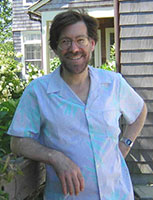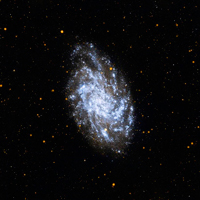Peter Friedman
Scientist Brings Solutions to a Galaxy of "Problems"
Profile by Sandi Beck

If there were a market for professional problem solving, Peter Friedman would qualify for the job. And, his resume would meet the criteria. Because Friedman, even as a youngster, has always looked for answers to puzzles and dilemmas. "I wasn't sure what field I wanted to enter," he says, talking about his dreams as a kid, "but I knew I wanted to have a chance to find solutions to interesting problems in my everyday work."
Now, as the Project Scientist for GALEX, Friedman has a lot of experience with searching out solutions. Over the past seven years he has used his problem-solving skills to bring the project's design requirements to fruition as a successful satellite mission. He has also acted as a liaison between the GALEX science team and engineers who designed and built the instrument and spacecraft, respectively, at NASA's Jet Propulsion Laboratory and at Orbital Sciences Corporation.
"We knew from the start that it was a difficult design problem to shoehorn the capabilities of a major ultraviolet survey instrument into the envelope of a Small-Explorer mission," says Friedman. "However, I don't think anyone on the team foresaw how many challenging problems would arise during the design and development. Solving those under pressure from tight schedules and budgets was the real challenge of GALEX."
To get to this point, Friedman earned a Bachelor of Arts in physics at the University of California (UC), Santa Cruz. He then went on to earn his doctorate in physics at UC Berkeley. While in graduate school he was part of the team that developed the first automated supernova search. Also, during that time he invented and built a low-noise ion detector used in a table-top cyclotron that did radioisotope dating. "The heart of that detector was a small microchannel plate," explains Friedman. "This is the same electron-multiplication technology that the GALEX detectors are based on."
Upon earning his Ph.D., he did postdoctoral work at Bell Labs, where he developed a laboratory apparatus to measure the lifetime of the positronium negative ion as a test of Quantum Electrodynamics theory. Then, in 1989 he joined the Columbia University research group led by Chris Martin, the present-day GALEX Principal Investigator. There, the two of them developed the first serpentine, crossed delay-line readout for a microchannel plate detector. As in the GALEX detectors, this readout uses fast pulse timing to provide position sensitivity.
GALEX's Instrument Scientist and Science Operations and Data Analysis Manager, David Schiminovich, was Martin's graduate student back then, and he worked with the pair to refine the detector. The three men then validated their design by flying four of this type of detector in a sounding rocket experiment called the Narrowband Ultraviolet Imaging Experiment for Wide-field Surveys (NUVIEWS). The experiment mapped the hot and cold gas in our galaxy over a quarter of the sky--with 5-10 arcminute imaging resolution--in five minutes above the atmosphere before the payload returned by parachute. "The ultraviolet background image from that initial NUVIEWS flight was the first to cover a substantial fraction of the sky," says Friedman.
Also at Columbia, Friedman and Martin worked on the GALEX predecessor satellite, JUNO. After a successful feasibility study, that project ended when the Italian government chose not to fund its part of the planned development.
By 1996 Friedman had joined Martin at the California Institute of Technology, where they proposed GALEX. When NASA selected the project, Friedman was named Project Scientist and began working with the instrument and spacecraft engineers. He worked especially closely with the instrument thermal engineers to find a thermal design that met GALEX's many thermal requirements, yet was simple enough to use on a small satellite. He also led the calibration effort, in which careful performance measurements of the assembled instrument were made in a thermal vacuum chamber at JPL. "After years of preparation, we spent a grueling month of round-the-clock shifts to make these measurements," remembers Friedman.
"Now that GALEX has launched, I've turned my attention to science. There, the problems are more interesting and fundamental, and we are matching wits with the cosmos, instead of just cost and schedule," he says. Friedman hopes that the promise of GALEX will be fulfilled by giving scientists greater precision in their understanding of star formation in galaxies. Such understanding will lead to insights into the physical parameters that drive star formation and regulate it's rate.
Friedman is also using GALEX to measure how much of the light that galaxies emit at wavelengths below 912 Angstroms escapes from galaxies without being absorbed. "This is called the Lyman Continuum escape fraction," he explains. "It is the source, along with quasars, of the photons that ionize the intergalactic medium--the dust and gas in the almost-empty space between galaxies."
According to Friedman, the Lyman Continuum escape fraction may depend on the star-formation rate in galaxies. And, since it helps determine the ionization of the intergalactic medium, it is probably important in regulating galaxy formation.
Friedman is confident that the GALEX legacy will be a data set that will live for decades. He predicts that far into the future, astrophysicists will still use it to investigate myriad puzzles about the nature of the Universe--many of which haven't even been thought of yet.
"GALEX has been the greatest thrill of my career," declares Friedman. "From proposal to operations, there were no shortage of problems to solve. However, we've had a great bunch of creative, clever, smart people to solve them. And, it has been very satisfying to be one of the problem solvers."




